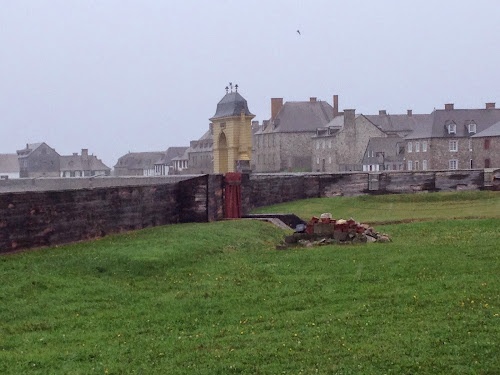The French and the British – where do we start in talking about them? They were at each other’s throats for hundreds of years. The French got off to a stronger start in building a stake in North America, but lost out in the end, except for two tiny islands off Newfoundland. But, the Fortress at Louisbourg played an interesting role in their dramas.
Founded in 1713, Louisbourg was a key transit point for the North Atlantic trade. Many ships would make for Louisbourg from Europe and then make their way down the coast to Boston, New York and Philadelphia. So, it was of tremendous strategic importance and there were impressive fortifications around the 2 1/2 to 3 mile circumference.
Indeed, there was a lot of unease among the British colonists in what are now the New England and Middle Atlantic states over the strength of the French fortress at Louisbourg and the threat posed by Catholic France to the colonists’ interests in fishing, trade and religion. It was the Province of Massachusetts Bay’s legislature that led a coalition of colonies (including New York, New Jersey, Rhode Island, Pennsylvania, Connecticut and New Hampshire) to form and provision an army and a naval force to attack the fortress. As part of the War of the Austrian Succession or King George’s War the New England coalition laid siege to the imposing fortress and succeeded in forcing a capitulation in 1745. Three years later, much to the annoyance of the British colonists, Britain traded Louisbourg back to the French. Then, in 1758 the British themselves laid siege to the fortress and laid it to ruin. Although the French seemed to be able to thrive in the harsh environment, the British detested the place and had no interest in allowing it to again become strategically important.
In the 1960s the Cape Breton mines closed and, to help provide jobs, development funds were found to reconstruct about 1/5 of the Fortress and furnish many of the buildings based on architectural drawings, archeology, and such documentation as household inventories. Today, it is a National Historic Site run by Parks Canada.
The Governor’s Apartments in the King’s Bastion, as well as many properties throughout the reconstruction, have costumed interpreters to bring the fortress to life.
Quite a number of artifacts have been returned to the fortress, including this cross looted in 1745 that is now on loan from Harvard University.
As for us, it was our only consistently miserable day so far. Despite the blowing rain, the Fortress of Louisbourg was a very interesting place to visit, filled with interpreters eager to share their early 18th century perspective.










